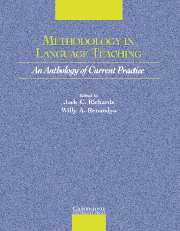Book contents
- Frontmatter
- Contents
- Acknowledgments
- Introduction
- Section I Approaches to Teaching
- Section 2 Lesson Planning and Classroom Management
- Section 3 Classroom Dynamics
- Section 4 Syllabus Design and Instructional Materials
- Section 5 Task and Project Work
- Chapter 9 Implementing Task-Based Language Teaching
- Chapter 10 Project Work: A Means to Promote Language and Content
- Section 6 Learning Strategies
- Section 7 Teaching Grammar
- Section 8 Teaching Pronunciation
- Section 9 Teaching Speaking
- Section 10 Teaching Listening
- Section 11 Teaching Vocabulary
- Section 12 Teaching Reading
- Section 13 Teaching Writing
- Section 14 Assessment
- Section 15 Technologies in the Classroom
- Section 16 Professional Development
- Credits
- Author Index
- Subject Index
- References
Chapter 10 - Project Work: A Means to Promote Language and Content
Published online by Cambridge University Press: 10 November 2010
- Frontmatter
- Contents
- Acknowledgments
- Introduction
- Section I Approaches to Teaching
- Section 2 Lesson Planning and Classroom Management
- Section 3 Classroom Dynamics
- Section 4 Syllabus Design and Instructional Materials
- Section 5 Task and Project Work
- Chapter 9 Implementing Task-Based Language Teaching
- Chapter 10 Project Work: A Means to Promote Language and Content
- Section 6 Learning Strategies
- Section 7 Teaching Grammar
- Section 8 Teaching Pronunciation
- Section 9 Teaching Speaking
- Section 10 Teaching Listening
- Section 11 Teaching Vocabulary
- Section 12 Teaching Reading
- Section 13 Teaching Writing
- Section 14 Assessment
- Section 15 Technologies in the Classroom
- Section 16 Professional Development
- Credits
- Author Index
- Subject Index
- References
Summary
INTRODUCTION
In recent years, increasing numbers of language educators have turned to content-based instruction and project work to promote meaningful student engagement with language and content learning. Through content-based instruction, learners develop language skills while becoming more knowledgeable citizens of the world. By integrating project work into content-based classrooms, educators create vibrant learning environments that require active student involvement, stimulate higher-level thinking skills, and give students responsibility for their own learning. When incorporating project work into content-based classrooms, instructors distance themselves from teacher-dominated instruction and move toward creating a student community of inquiry involving authentic communication, cooperative learning, collaboration, and problem solving.
In this article, I shall provide a rationale for content-based instruction and demonstrate how project work can be integrated into content-based classrooms. I will then outline the primary characteristics of project work, introduce project work in its various configurations, and present practical guidelines for sequencing and developing a project. It is my hope that language teachers and teacher educators will be able to adapt the ideas presented here to enhance their classroom instruction.
A RATIONALE FOR CONTENT-BASED INSTRUCTION
Content-based instruction (CBI) has been used in a variety of language learning contexts, though its popularity and wider applicability have increased dramatically since the early 1990s. Numerous practical features of C-I make it an appealing approach to language instruction:
In a content-based approach, the activities of the language class are specific to the subject matter being taught, and are geared to stimulate students to think and learn through the use of the target language. […]
- Type
- Chapter
- Information
- Methodology in Language TeachingAn Anthology of Current Practice, pp. 107 - 120Publisher: Cambridge University PressPrint publication year: 2002
References
- 37
- Cited by

